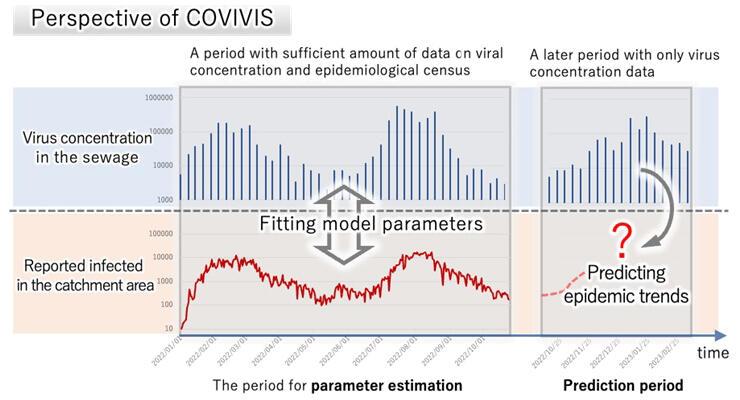On June 21, a research group led by Professor Akira Sasaki of the Research Center for Integrative Evolutionary Science at the Graduate University for Advanced Studies, SOKENDAI, the National Institute of Infectious Diseases, and Science Groove (Chief Executive Officer: Yuya Miyazaki) announced that they developed and launched a data analysis method and web application "COVIVIS (https://covivis.soken.ac.jp)" to predict the number of infected people in a watershed based on measurement data on virus concentrations in sewage. Analysis results can be output in about 5 minutes and applied to infectious diseases other than COVID-19 (SARS-CoV-2). They plan to upgrade the application and accumulate analysis results through several implementation tests.

Provided by SOKENDAI
"Sewage surveillance," in which sewage concentrations of viruses, including SARS-CoV-2, are measured to understand the infection status in the watershed, has been introduced nationwide. A method for measuring virus concentrations in sewage using quantitative polymerase chain reaction (PCR) has been established. The technological adaptation to conditions specific to the measurement locations, such as the water quality and flow rate, is underway. In some municipalities, analysis of acquired data has demonstrated the feasibility of estimating the number of infected people based on the virus concentrations in sewage.
These research projects were conducted as pilot projects in the early stages of the COVID-19 pandemic. Now a nationwide virus concentration measurement network is being established. Accordingly, there is a growing need for analytical tools that can be used by municipalities to estimate the number of infected people in a simple and comprehensive manner.
COVIVIS was researched and developed as part of the "New Integrated Japanese Sewage Investigation for COVID-19" by an industry-academia-government research team. Both sewage virus concentration and epidemiological data on the number of infected people in that watershed must be sufficiently available to predict the number of infected people. COVIVIS estimates a mathematical model for bidirectional prediction of these two time-series data, inputs the model parameters and new virus concentration data into the prediction model, and outputs a predicted number of newly infected people. The virus concentration and epidemiological data for a certain period in the past and the virus concentration data for a new period to be predicted are three types of data input into the analysis tool. In response to the input data, the analysis tool outputs the number of infected people for the new period to be predicted. It consists of a parameter estimation form and a form for predicting the number of cases. The tool allows users to obtain model parameters according to the latest variants and regional characteristics. These model parameters facilitate fitting the infection situation in the target area to the virus concentrations in sewage, allowing automatic adaptation to parameter changes due to differences in measurement methods and water quality characteristics, substitution of variants, and changes in people's behavior in each surge.
Other functions implemented are the preprocessing of time-series data on sewage virus concentration and the number of positive reports (such as lower detection limit, moving average, and interpolation of missing data points), backward estimation of data on the number of positive reports from the release date base to the onset date base, and saving analysis results to the server and sharing analysis results with other users. The same method was used to analyze SARS-CoV-2 data measured in urban areas in Japan. The results showed that the virus concentrations in the sewage fitted the number of positive reports precisely (coefficient of determination, 0.7-0.8). The virus detection level from infected individuals was estimated to peak 0−1 day after onset, with very steep declines of 1−2 days before and after the peak, indicating a significant contribution of oral secretions to virus concentrations in sewage. Furthermore, a sewage census was effective in knowing the infection status if there was only one infection per 100,000 people.
Account registration is required to use COVIVIS, and registration authorization is handled individually. The assumed users include universities, other research institutions, and researchers who have already conducted research or data analysis related to sewage surveillance.
Sasaki said, "There have been difficulties in understanding the regional infection status of SARS-CoV-2. One of the difficulties is the time lag between the time of diagnosis of a symptomatic patient and the time of report of the patient to the local government. Another difficulty is the fact that the infection reports do not reflect subclinical infections, which account for a large percentage. We started a mathematical biology study to test if the regional infection status could be monitored in real-time through sewage surveillance, which does not require direct specimen collection from patients. The study led to the development of this general-purpose web application."
This article has been translated by JST with permission from The Science News Ltd. (https://sci-news.co.jp/). Unauthorized reproduction of the article and photographs is prohibited.




